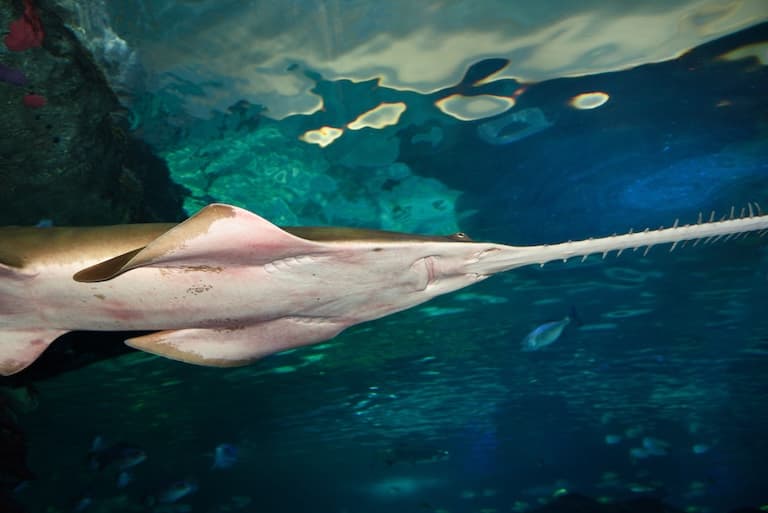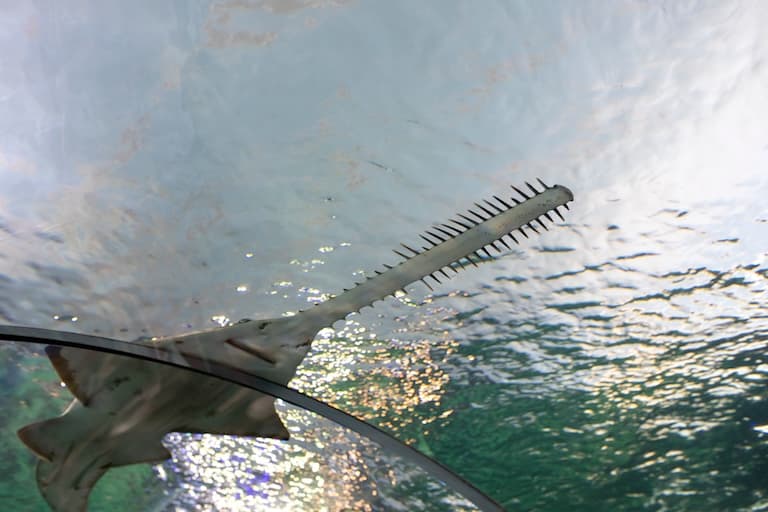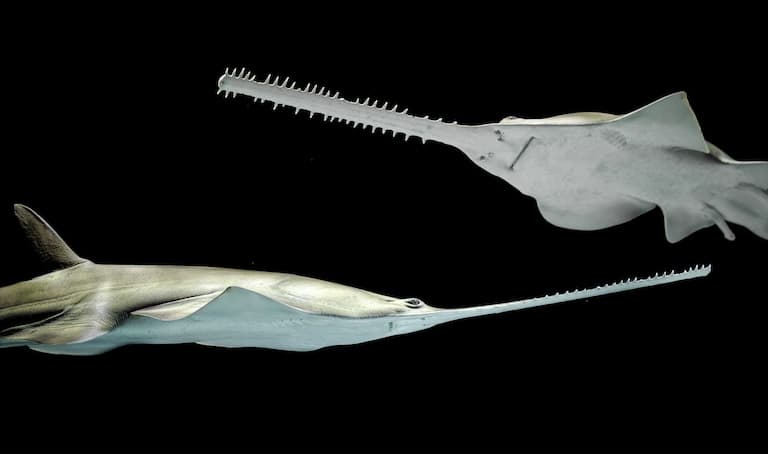Longcomb Sawfish Profile
To steal a joke from The Simpsons (again), when the aboriginal Australians first came across this animal, they rejected the obvious “Saw, fish” and with miraculously colonial accents probably said something like, “What? That’s an odd name, I’d have called them Dindagubbas”.
And so, they did. But when scientists discovered the sawfish much, much later, they didn’t do any better.
With a specific name derived from a cat walking across a keyboard, Pristis zijsron, or the longcomb sawfish, is a bizarre giant whose novel evolutionary adaptation has recently become its handicap.

Longcomb Sawfish Facts Overview
| Habitat: | Tropical and subtropical marine |
| Location: | Indo-Pacific |
| Lifespan: | 24 years |
| Size: | Up to 7.3 m (24 ft) long |
| Weight: | Up to 700 kg (1,540 lb) |
| Colour: | Sandy brown |
| Diet: | Fish, crustaceans, molluscs |
| Predators: | Mostly humans, also large crocodiles |
| Top Speed: | Unknown |
| No. of Species: | 1 |
| Conservation Status: | Critically Endangered (IUCN) |
The ancient sawfish is one of the more alien of the cartilaginous fishes, combining a body and nose that act like a metal detector, with a powerful cutting tool for both killing and carpentry.
This nose is more than just a strange-looking appendage, it’s the solution to an ecological problem that has served the species well for tens of millions of years.
Unfortunately, it is now this very tool that is putting species like the longcomb sawfish near the top of the list for urgent conservation action, as the combination of a toothy beak and modern fishing nets is proving to be utterly devastating to the animal.
Interesting Longcomb Sawfish Facts
1. Dindagubba
Sharks have been around for so long, that it’s possible that rays evolved from sharks and sharks just kept going.
The evolutionary link between the two groups of cartilaginous fishes isn’t clear yet, partly because cartilage doesn’t fossilise well, but it’s sometimes said that sawfish evolved from primitive sharks around the time rays were invented.
Rays diverged from sharks around 200 million years ago, which is about halfway between now and when sharks first showed up. It’s thought they adapted to bottom-dwelling by flattening out and becoming sandy-coloured.
Sawfish come from this line of rays, showing up clearly in the fossil record from around 60 million years ago, and while they weren’t the first to evolve the saw – that was the saw skates, no extinct – they are the oldest to hold one now.
Being so old, they were of course around long before humans, who showed up in Australia around 85,000 years ago and immediately set to work giving funny names to everything.
Unfortunately by the time they found the sawfish, “Chazzwazzers” had already been taken, so they went with Dindagubba.
2. They’re huge
And what a Dindagubba! Of all the sawfish species, the longcomb is likely the largest, with records showing a maximum length of seven metres long.
There are also claims of this animal weighing up to 700 kilos, which is a colossal weight for such a fish, especially considering it has no bones. 1

3. We don’t know all that much about their lives
Despite being enormous, these fish are increasingly rare in modern times, and surprisingly little is known about them.
They are found on the continental shelf, down to 100 metres, and reproduce in the mangrove nurseries and estuaries further away from the dangers of the ocean. It’s thought they can live for at least 24 years, but the age of maturity and mating patterns are uncertain.
What else is known about this animal mostly revolves around its long nose. 2
4. They have teeth
Sharks are well known for having teeth, it’s one of the things they do best. But the teeth in their mouths, numerous as they can be, number few in comparison to those on their bodies.
Sharks and rays have sandpapery skin – this texture is a product of what are known as “dermal denticles” which are developmentally related to the teeth you find in the mouth.
In fact, these denticles are thought by many to be the origins of teeth, and in the sawfish’s saw, they very much support this hypothesis.
The teeth on the rostrum of the sawfish begin life as dermal denticles and migrate onto the rostrum at later stages of development, forming much larger and more recognisable “teeth”, becoming more specialised and forming the characteristic saw which makes these animals so instantly recognisable.
Unfortunately for the fish, this has drawn the attention of humans for thousands of years. 3

5. They’re sought-after
From the moment the sawfish caught the eye of early humans, it has made its way into ceremonial practices and ideas.
The saw itself is both a weapon for slashing at its fishy prey, and a long rod that is filled with electroreceptors to find them under the sand. Unfortunately, this has little significance to most people who just think it looks cool and will often steal it, killing the fish in the process.
But it’s not just the saw, sawfish fins are among the most prized in the finning industry, and the meat is popular, too.
This is the reason that today, the longcomb sawfish is found in just a fraction of its previous range.
6. Their range has significantly declined
Already this species has become extinct in two of its historical 37 countries, and only 11 of the remaining countries are certain they still have one. This is a reduction of over 60% of its previous range, and it’s only getting worse.
The population as a whole has dropped by more than 80% in just three generations, and this has contributed to its classification as critically endangered.
Being such a huge and powerful fish, this species has few predators outside of humans, so there’s really nobody else to blame.
7. They’re in serious trouble
The Species Red List, among similar rankings, details the condition of a single species, summing up its populations worldwide and giving a ranking based on its condition now and its trajectory.
If a species is small but stable and has a naturally narrow range, it may well be of least concern, despite there being very few individuals around.
Conversely, if there are tens of thousands of them but they’re hurtling towards zero rather rapidly, this might be cause for great concern.
But looking at this ranking system alone doesn’t paint the full picture. For example, a species could appear to be doing well, despite being eradicated from 90% of its historical range, having experienced local extinctions, and leaving behind all the ecological effects that come with that.
Unfortunately, this isn’t the case with the longcomb sawfish. Not only are local extinctions commonplace in the recent history of this species, but there are no two ways about it: this is a species that we will soon lose forever if changes can’t be made to the fishing industry.

8. The fishing industry is a scourge
It’s easy from a Western perspective to point to practices we don’t engage with like shark finning as a despicable and destructive fashion that is rapidly sterilising our oceans, but we are more complicit with this destruction than we would like to believe.
The Indo-Pacific is the finning capital of the ocean, but many of the fisheries involved in it belong to some of the greatest exporters of seafood to the rest of the world, and while hundreds of millions of sharks are killed for fin soup, far more are killed as bycatch from the nets used to catch our seafood, in every ocean.
Industrial seafood is regulated better in some places than others, but it continues to decimate non-targeted species, and as the targeted populations drop, the response is to send out more boats and throw down more nets, increasing bycatch and causing exponential more damage to the marine ecosystems.
And with the majority of the damage occurring out to sea, the industry benefits from a huge amount of “out of sight, out of mind” when it comes to public outcry.
The longcomb sawfish, as the name suggests, does not pass through nets easily, and is under tremendous threat from most forms of fishing in its range.
Add to this the degradation of mangroves and other freshwater breeding habitats, and there aren’t many safe places left for this species. Western Australia now represents the world’s best hope of protecting the longcomb sawfish and one that must remain protected if the species is to survive. 4
Longcomb Sawfish Fact-File Summary
Scientific Classification
| Kingdom: | Animalia |
| Phylum: | Chordata |
| Class: | Chondrichthyes |
| Order: | Rhinopristiformes |
| Family: | Pristidae |
| Genus: | Pristis |
| Species: | zijsron |
Fact Sources & References
- Nicole M. Phillips (2015), “Sawfish. Ancient predators in need of modern conservation tools”, Research Gate.
- “Green Sawfish”, IUCN Red List.
- Monique Welten (2015), “Evolutionary origins and development of saw-teeth on the sawfish and sawshark rostrum (Elasmobranchii; Chondrichthyes)”, The Royal Society.
- Melissa Cristina Márquez, (2024), “Western Australia Unveiled As Global Sanctuaries For Elusive Rays”, Forbes.
